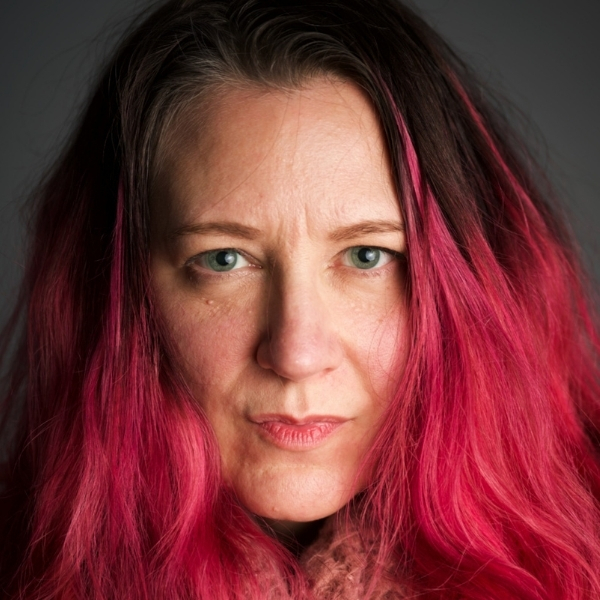
Dear Cami
There are so many ways to talk about power. Today, I want to start with the kind that fits in a profile picture.
Because before we ever speak, before we’re known, we’re seen. And in this century, we’re not just seen across a room — we’re seen across platforms. Our faces, our bios, our avatars, all carrying stories people decide are true before they’ve even met us. That’s power too: the kind that shrinks a whole human down to 400×400 pixels.
So with that, welcome back to Dear Cami, a monthly advice column for neurodivergent folks (and the people who love us). It’s a place for honesty, curiosity, and side-eye at the systems making everything harder than it needs to be.
This month’s letter comes from Cover Story.
A vintage human with more avatars than most of us have selfies, wondering what it means when our digital masks get judged harder than the people underneath.
“I would love to ask you how you approach Avatar identity on all these splinted platforms, from social to workplace? If people judge a book by its cover, what does that mean for our digital self and how we identify in our 21st-century cultural norms, knowing that times will change?”
Dear Cover Story,
In a world where we can “know” more about a stranger with five minutes of internet searching than we know about our next-door neighbors after a year, there’s an incredible amount of power in curating your public persona. What used to be a problem for politicians and movie stars is now everyone’s problem.
There were times in my career when I had to “vet” people for a program, to make sure they respected the rules, policies, and code of conduct. My daughter called it mommy’s internet-stalking time. She wasn’t wrong. I saw so many sides of every person I researched. Was I just looking at LinkedIn and GitHub? Nope. I checked everything. It was my job — and I had so. much. power. (Picture Skeletor cackling and running offscreen.) Knowledge is power. One of those big truths they fed us in childhood, hoping we wouldn’t listen too closely. Spoiler: some of us were taking notes.
And now we have that power in the palms of our hands. Literally. Supercomputers in our pockets we call phones (even though making calls is the last thing we want to do with them). They open us to a world of knowledge. But they can also leave us open to the world. Once something is on the internet, it’s forever. Or at least until the end of the world.
As you called out in your letter, times do change. Ever watch a movie from the 80s you thought was hilarious when you were young? Some things don’t age well… Bender hiding from Principal Vernon under Claire’s table seemed funny when everyone was laughing along. Now I hope we can all agree it was sexual assault.
Once I saw that, I couldn’t unsee it. I couldn’t go back to the naive state of my youth when we acted like it was okay for the cute ruffian to do that. That kind of shift in cultural norms — that’s what we’re talking about here.
As I was saying, knowledge is power. And we’re sharing so much about ourselves. So what do we do with that? For me, the biggest power play I’ve made online is choosing to be open about my various labels, diagnoses, and differences across the board. Professional sites? Yep. Personal? Check. Random profiles? Too many. Because once the information is in one place, it might as well be in them all.
Not because I think the internet is owed that information, but because I hope it empowers others like me. Empower. Power. See the connection?
So I’d love to tell you I manage my avatars with the careful precision of an autistic woman armed with a spreadsheet, an obsession, and a plan to never disclose anything that could ever be cringe or held against me if the world should shift under my feet… But mostly? I handle it like a woman with ADHD throwing scissors into a junk drawer and praying (despite my lack of faith in a higher being) that I’ll be able to close it and maybe, just maybe, open it again someday. And if it never opens again, fine — future archaeologists can deal with it.
So what should you do with all this? I think avatars — whether it’s your profile photo, your bio, or the pieces of yourself scattered across platforms — deserve to be carefully written and occasionally reviewed. That way, you know who you are — even if no one else stitches the fragments together.
But “shoulds” are wonderful things, aren’t they? This is a classic “do as I say, not as I do” situation. Because no matter how carefully we plan, our digital selves get messy. Outdated bios. Profile pictures that no longer look like us. Vague posts on platforms we don’t even remember signing up for. (Looking at you, Plurk.)
And that’s okay. Identity isn’t static. Neither are the times we’re living in. What feels right now might look dated, or even cringeworthy, ten years from now. But it’s still a record of who you were in that moment, whether you like it or not.
So yes, we should write them carefully. Review them now and then. But also give yourself permission for them to be imperfect. Maybe even contradictory. That’s not a flaw. It’s the truth of living in changing times.
Your unreliable narrator,
Cami
Psst.
If you’ve got a question—something tender, messy, or just too weird to say out loud at work, with friends, or at family dinner—you can ask me.
Dear Cami is open to neurodivergent folks and the people who love us.
You don’t have to make it nice. Just make it honest.
Cami Kaos is a writer, autistic woman, and former tech community organizer who spent more than a decade building inclusive spaces in an industry that rarely made room for people like her. After burning out from constant caretaking and code-switching, she turned inward—to reclaim the parts of herself that were silenced to make others comfortable. Cami writes about identity, survival, and neurodivergence—not always without apology, but with growing conviction. These days, she’s not interested in holding it all together anymore—just holding what matters. You can find Cami at camikaos.com. Bring snacks.

Lorem ipsum dolor sit amet, consectetur adipiscing elit. Suspendisse varius enim in eros elementum tristique. Duis cursus, mi quis viverra ornare, eros dolor interdum nulla, ut commodo diam libero vitae erat. Aenean faucibus nibh et justo cursus id rutrum lorem imperdiet. Nunc ut sem vitae risus tristique posuere.
Lorem ipsum dolor sit amet, consectetur adipiscing elit. Suspendisse varius enim in eros elementum tristique. Duis cursus, mi quis viverra ornare, eros dolor interdum nulla, ut commodo diam libero vitae erat. Aenean faucibus nibh et justo cursus id rutrum lorem imperdiet. Nunc ut sem vitae risus tristique posuere.